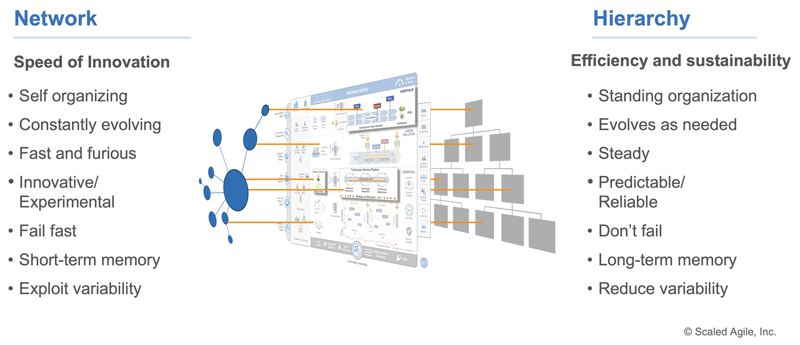
The Top 9 Factors That Lead To Failure:
- Lack of executive sponsorship: Without strong executive sponsorship, it can be difficult to gain the support and resources needed to successfully complete a enterprise transformation.
- Lack of clear vision and strategy: Without a clear vision and strategy, it can be difficult to align the efforts of the organization and ensure that all parties are working towards the same goals.
- No clear measurement of outcomes: Without a clear path to success, the organization can veer away from focusing on delivering core value to stakeholders.
- Insufficient resources: Enterprise transformations Enterprise transformations often require significant resources, including funding, personnel, and technology. If these resources are not available, the transformation may not be able to be completed as planned.
- Ignoring the dual operating system: Ignoring (or not acknowledging) the existence of a dual operating system of the organization (the "old system") and the new operating system that is being implemented as part of the transformation (the "new system").
- Resistance to change: Many people resist change, and this can be especially true in large organizations where there may be long-standing traditions and ways of doing things. Resistance to change can be a significant barrier to the success of a transformation.
- Complexity: Enterprise transformations can be complex, involving many different stakeholders and processes. This complexity can make it difficult to manage the transformation effectively, leading to delays and setbacks.
- Poor communication: Clear and effective communication is critical to the success of any transformation. If communication is poor, it can be difficult to ensure that all parties are aligned and working towards the same goals.
- Ineffective governance: Ineffective governance can lead to confusion and chaos, making it difficult to successfully implement a transformation.
Lack of Executive Sponsorship
Lack of executive sponsorship can be a significant barrier to the success of enterprise transformations transformations. Executive sponsorship involves senior leaders within the organization taking an active role in supporting and advocating for the transformation. Without this support, it can be difficult to gain the resources, funding, and personnel needed to successfully complete the transformation.

In addition, executive sponsorship helps to ensure that the transformation is aligned with the overall goals and priorities of the organization. This can be especially important in large organizations where there may be many different stakeholders and competing priorities.
To address the issue of lack of executive sponsorship, it is important for organizations to engage senior leaders in the transformation process as early as possible. This may involve providing them with information about the benefits of the transformation, as well as any potential risks or challenges. It is also important to involve them in key decision-making processes and to keep them informed about the progress of the transformation.
No Clear Measurement of Outcomes
Measuring outcomes is an important step in the process of an enterprise transformations. It helps organizations to assess the effectiveness of the transformation and determine whether it is meeting its goals and objectives.
There are several ways that organizations can measure outcomes during a transformation:
- Set clear metrics and targets: Establish clear metrics and targets for the transformation, and track progress regularly to ensure that the transformation is on track.
- Use data and analytics: Utilize data and analytics to measure the impact of the transformation on key business metrics, such as productivity, customer satisfaction, and financial performance.
- Conduct surveys and focus groups: Conduct surveys and focus groups with employees, customers, and other stakeholders to gather feedback on the transformation and assess its impact.
- Perform a post-transformation review: After the transformation is complete, conduct a thorough review to assess the outcomes and identify any areas for improvement.
Lack of Clear Vision and Strategy
While businesses of any size are vulnerable to a lack of clear vision and strategy, it’s one of the primary reasons that enterprise transformations can fail. A clear vision and strategy provide a roadmap for the transformation, outlining the goals, objectives, and milestones that need to be achieved. Without this roadmap, it can be difficult to align the efforts of the organization and ensure that all parties are working towards the same goals.
Having a clear vision and strategy also helps to ensure that the transformation is aligned with the overall mission and goals of the organization. This can be especially important in large organizations where there may be many different stakeholders and competing priorities.
To develop a clear vision and strategy, it is important to engage all relevant stakeholders, including executives, employees, customers, and other key stakeholders. This helps to ensure that the transformation is grounded in the needs and goals of the organization, and that all parties are committed to the success of the transformation.
Insufficient Resources
Insufficient resources can be a major factor in the failure of enterprise transformations. These types of transformations often require significant resources, including funding, personnel, and technology. If these resources are not available, it can be difficult to successfully complete the transformation as planned.
For example, if an organization does not have enough funding to hire the personnel needed to implement a new system or process, it may struggle to make progress. Similarly, if an organization does not have access to the necessary technology, it may not be able to fully leverage the capabilities of the new system or process.
To address the issue of insufficient resources, it is important for organizations to carefully plan their transformations, including identifying the resources that will be needed and making sure that they are available. This may involve seeking additional funding, negotiating with vendors for better terms, or finding other ways to secure the resources needed to complete the transformation. As alluded to earlier in this article, engaging leadership from the Human Resources (HR) and Finance organizations could help ensure you are leveraging good best practices when hiring and engaging human and capital resources.
Ignoring the dual operating system
The concept of a "dual operating system" as applied to enterprise transformations was developed by John Kotter, a leading expert on organizational change. According to Kotter, a dual operating system involves maintaining both the existing operating system of the organization (the "old system") and the new operating system that is being implemented as part of the transformation (the "new system").

Kotter suggests that this approach can be effective in managing the complexity of an enterprise-level transformation. By maintaining both systems in parallel, the organization can continue to operate and deliver value to its customers while also implementing the changes needed to achieve its long-term goals.
However, Kotter also cautions that a dual operating system can be difficult to maintain over the long term, as it requires significant coordination and resources. It is important for organizations to carefully plan and manage this process to ensure that both systems are operating effectively and efficiently.
Resistance to Change
Resistance to change is a common issue that can arise during enterprise transformations. People are naturally resistant to change, especially when it involves significant changes to their work environment or processes. This can be especially true in large organizations where there may be long-standing traditions and ways of doing things.
There are many factors that can contribute to resistance to change, including:
- Lack of understanding: If people do not understand the reasons behind the change or how it will benefit them, they may be more resistant to it.
- Fear of the unknown: Change can be unsettling, and people may be afraid of the unknown consequences of the change.
- Lack of control: If people feel like they have no control over the change, they may be more resistant to it.
- Personal loss: Change can often involve the loss of certain things, such as familiar processes or relationships, which can be difficult for people to accept.
To address resistance to change, it is important for organizations to engage all relevant stakeholders in the change process, including employees, customers, and other key stakeholders. This helps to ensure that everyone understands the reasons behind the change and how it will benefit them. It is also important to be transparent and open about the change process, and to address any concerns or issues that may arise. Engaging leadership, employees or even consultants who are experienced in change management would be a wise endeavor. It involves tasking as designated group of people responsible for identifying the need for change, developing a plan for implementing the change, and then executing and monitoring the plan to ensure that the change is successful.
Overall, Organizational Change Management or (OCM) is a critical component of the success of any enterprise-level transformation, and it is important for organizations to invest the time and resources needed to effectively plan and manage the change process.
Complexity
Complexity is another factor that can contribute to the failure of enterprise transformations. These types of transformations often involve many different stakeholders and processes, and it can be difficult to manage the complexity effectively. This can lead to delays and setbacks, which can ultimately undermine the success of the transformation.
To address complexity, it is important for organizations to carefully plan and manage their transformations. This may involve breaking the transformation down into smaller, more manageable projects or phases, and establishing clear roles and responsibilities for all stakeholders. It may also involve implementing effective governance and project management processes to ensure that the transformation stays on track.
In addition, it can be helpful to utilize tools and technologies that can help to simplify and streamline the transformation process. For example, project management software, collaboration platforms, and other tools can help to improve communication and coordination among stakeholders, reducing complexity and increasing the chances of success.
Poor Communication
Poor communication is another factor that can contribute to the failure of enterprise transformations. Clear and effective communication is critical to the success of any transformation, as it helps to ensure that all parties are aligned and working towards the same goals. Without effective communication, it can be difficult to ensure that everyone is on the same page, leading to confusion and misunderstandings.
There are several ways that organizations can improve communication during a transformation:
- Establish clear channels of communication: Make sure that there are clear channels of communication in place, and that all stakeholders know how to access them.
- Regularly communicate progress and updates: Keep all stakeholders informed about the progress of the transformation and any updates or changes that may occur.
- Encourage open and honest communication: Encourage open and honest communication among all stakeholders and be willing to listen to and address any concerns or issues that may arise.
- Use multiple forms of communication: Utilize a variety of communication channels, including face-to-face meetings, email, and collaboration tools, to ensure that everyone has access to the information they need.
Ineffective Governance
Ineffective governance is another factor that can contribute to the failure of enterprise transformations. Governance refers to the systems, processes, and structures that are in place to ensure that the transformation is being carried out effectively and efficiently. Without effective governance, it can be difficult to manage the transformation effectively, leading to confusion and chaos.
Th 4 major things that organizations can do to improve governance during a transformation:
- Establish clear roles and responsibilities: Make sure that all stakeholders know their roles and responsibilities in the transformation process, and that there is a clear chain of command for decision-making.
- Implement effective project management processes: Use project management processes, such as agile or waterfall, to ensure that the transformation stays on track and that all stakeholders are aligned.
- Utilize technology: Use tools and technologies, such as project management software and collaboration platforms, to improve communication and coordination among stakeholders.
- Establish clear metrics: Set clear metrics and targets for the transformation, and track progress regularly to ensure that the transformation is on track.
To summarize and recommend a path forward to developing a roadmap, there are several steps that organizations can take to increase the chances of success for an enterprise-level transformation.
It starts with what John Kotter described as “Building a Guiding Coalition”. This means ensuring that all levels of the organization engaged in the initiative. Executive sponsorship is a critical component of the success of an enterprise-level transformation, and it is important for organizations to ensure that they have strong executive sponsorship in place.
After it’s clear that leadership is fully engaged, then work with everyone and anyone who can influence the effort of developing a clear vision and strategy for the transformation; outlining the goals, objectives, and milestones that need to be achieved. This means engaging all relevant stakeholders, including employees, customers, and other key stakeholders, in the transformation process.
Recognize the dual operating system can be a useful approach for organizations to consider when managing the complexity of an enterprise-level transformation. Then carefully assess the resources that will be needed for the transformation, including funding, personnel, and technology, and ensure that they are available. Anticipate and address resistance to change, by engaging all stakeholders in the change process and addressing any concerns or issues that may arise.

Plan and manage the transformation, breaking it down into smaller, more manageable projects or phases if necessary, and implementing effective governance and project management processes. Establish clear channels of communication and regularly communicate progress and updates to all stakeholders.
Lastly, it is important for organizations to regularly measure the outcomes of their enterprise transformations to ensure that they are meeting their goals and objectives, and to identify any areas for improvement.
Need help with your enterprise transformation?
Start with an Agility Assessment by Agility Engineers.
https://app.appointmatic.io/agility-engineers/assessments
--

Executive Director, Agile Services & Delivery
(678) 831-5700
AgilityEngineers.com
cw@agilityengineers.com
Johns Creek, GA
Join & Search Our Directory of Engineers & Practitioners - https://www.agility-engineers.com
 Add Row
Add Row  Add
Add 




Write A Comment